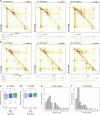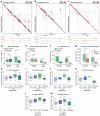CTCF depletion decouples enhancer-mediated gene activation from chromatin hub formation
- PMID: 40360814
- PMCID: PMC12263429
- DOI: 10.1038/s41594-025-01555-z
CTCF depletion decouples enhancer-mediated gene activation from chromatin hub formation
Abstract
Enhancers and promoters interact in three-dimensional (3D) chromatin structures to regulate gene expression. Here we characterize the mechanisms that drive the formation and function of these structures in a lymphoid-to-myeloid transdifferentiation system. Based on analyses at base pair resolution, we demonstrate a close correlation between binding of regulatory proteins, formation of chromatin interactions and gene expression. Multi-way interaction analyses and computational modeling show that tissue-specific gene loci are organized into chromatin hubs, characterized by cooperative interactions between multiple enhancers, promoters and CTCF-binding sites. While depletion of CTCF strongly impairs the formation of these chromatin hubs, the effects of CTCF depletion on gene expression are modest and can be explained by rewired enhancer-promoter interactions. These findings demonstrate a role for enhancer-promoter interactions in gene regulation that is independent of cooperative interactions in chromatin hubs. Together, these results contribute to our understanding of the structure-function relationship of the genome during cellular differentiation.
© 2025. The Author(s).
Conflict of interest statement
Competing interests: The authors declare no competing interests.
Figures












Similar articles
-
High-resolution CTCF footprinting reveals impact of chromatin state on cohesin extrusion.Nat Commun. 2025 May 15;16(1):4506. doi: 10.1038/s41467-025-57775-w. Nat Commun. 2025. PMID: 40374602 Free PMC article.
-
Cohesin stabilization at promoters and enhancers by common transcription factors and chromatin regulators.Epigenetics Chromatin. 2025 Jun 9;18(1):33. doi: 10.1186/s13072-025-00598-2. Epigenetics Chromatin. 2025. PMID: 40490791 Free PMC article.
-
EBNA leader protein orchestrates chromatin architecture remodeling during Epstein-Barr virus-induced B cell transformation.Nucleic Acids Res. 2025 Jun 20;53(12):gkaf629. doi: 10.1093/nar/gkaf629. Nucleic Acids Res. 2025. PMID: 40598900 Free PMC article.
-
Mechanisms of Enhancer-Mediated Gene Activation in the Context of the 3D Genome.Annu Rev Genomics Hum Genet. 2025 Aug;26(1):163-188. doi: 10.1146/annurev-genom-120423-012301. Epub 2025 Mar 3. Annu Rev Genomics Hum Genet. 2025. PMID: 40030157 Review.
-
Chromatin insulator mechanisms ensure accurate gene expression by controlling overall 3D genome organization.Curr Opin Genet Dev. 2024 Aug;87:102208. doi: 10.1016/j.gde.2024.102208. Epub 2024 May 28. Curr Opin Genet Dev. 2024. PMID: 38810546 Free PMC article. Review.
Cited by
-
3D Genome Engineering: Current Advances and Therapeutic Opportunities in Human Diseases.Research (Wash D C). 2025 Sep 1;8:0865. doi: 10.34133/research.0865. eCollection 2025. Research (Wash D C). 2025. PMID: 40901634 Free PMC article. Review.
-
Multiscale information processing in the immune system.Front Immunol. 2025 Jul 21;16:1563992. doi: 10.3389/fimmu.2025.1563992. eCollection 2025. Front Immunol. 2025. PMID: 40761781 Free PMC article. Review.
References
MeSH terms
Substances
LinkOut - more resources
Full Text Sources

